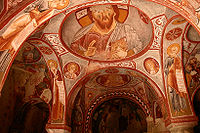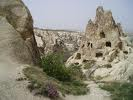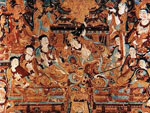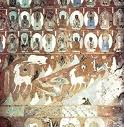



Silk Road Trade & Travel Encyclopedia
丝绸之路网站(丝路网站)
丝绸之路百科全书—游客、学生和教师的参考资源
İPEK YOLU ve YOLLARI ANSİKLOPEDİSİ
www.ipekyollari.net

Silk Road Trade & Travel Encyclopedia
丝绸之路网站(丝路网站)
丝绸之路百科全书—游客、学生和教师的参考资源
İPEK YOLU
ve YOLLARI
ANSİKLOPEDİSİ
www.ipekyollari.net
F
A B
C
D
E
F
G
H I
J
K
L
M
N O P
Q
R
S
T
U V
W
X
Y
Z
Fadlan
Ahmad Ibn Fadlan was sent as ambassador from the Abbasid Caliph to the ruler of
the Bulgars on the middle Volga River (921-922 CE). The route went from Baghdad via the
territories of the Samanid state and its capital Bukhara, through Khwarezm and
north of the Caspian Sea.
Famen Temple Built during the Eastern Han Dynasty (25 AD -220 AD) in Xi'an China, with a history of 1,700 years, Famen Temple preserves the relic of the finger bone attributed to Sakyamuni Buddha. At the center of the temple is 13-tiered octagonal pagoda under which, it is said, a sliver of the finger bone of Sakyamuni was discovered. An underground palace is thought to have been established during the Tang Dynasty (618 - 907), when precious treasures were stored under the pagoda. The pagoda has been re-built several times, and is now made of brick.
Far East The term "Far East" came into use in European geopolitical discourse in the 19th century, denoting Eastern Asia as the "farthest" of the three "easts," beyond the Near East and the Middle East. For the same reason, the ancient Chinese called western countries "Tàixī (泰西)"—i.e. anything further west than India. The term is no longer commonly used, as it connotes the "orientalism" of the 19th century as described by Edward Said. Today terms like East Asia and the Orient are more common. The term Far East was popularized in the English language during the period of the British Empire as a blanket term for lands to the east of British India. Prior to World War I, the Near East referred to relatively nearby lands of the Ottoman Empire, Middle East to northwestern South Asia and Central Asia, and Far East for countries along the western Pacific Ocean and countries along the eastern Indian Ocean. Many European languages have analogous terms, such as the French Extrême-Orient, Spanish Extremo Oriente, Portuguese Extremo Oriente, German Ferner Osten, Italian Estremo Oriente, Polish Daleki Wschód, and Dutch Verre Oosten. There is a combination of cultural and geographic subjectivism associated with the term, since the term rarely refers to the culturally Western nations of Australia and New Zealand, which lie even farther to the east of Europe than East Asia itself. (See "Eastern World") More...
Fatih Sultan Mehmet (also known as "Mehmet the Conqueror" or Mehmet II) was the Ottoman Sultan who at the age of 21 in 1453, conquered Constantinople (modern-day Istanbul). When Mehmed II ascended the throne in 1451, he devoted himself to strengthening the Ottoman navy, and in the same year made preparations for the taking of Constantinople. He continued his conquests in Asia, through Anatolia, and also conquered lands in Europe, as far as Belgrade. There are many highlights to his 31-year rule, including the fact that he was the first Sultan to codify criminal and constitutional law (before Suleiman the Magnificent, known as "the Lawmaker" or "Kanuni"). One of the bridges in Istanbul which connects Europe and Asia is named after Fatih Sultan Mehmet. More...
Faxian (Fa-hsien) Once Buddhism became established in China, many Chinese devotees wished to make the journey to India, the sacred land in which Buddhism was born. The Silk Road was only land route by which the journey could be made, and despite the danger and length of the journey, many monks attempted it. The journeys of two monks, Faxien and Xuanzang, became famous because of the accounts which they wrote about their travels. Faxian traveled the southern route through Shenshen, Dunhuang, Khotan, and then over the Himalayas, to Gandhara, Peshawur then India. He journeyed most of the way on foot and was the first known traveler passing through the Taklamakan desert from Woo-e to Khoten. More...
Thus, Faxian was the first Chinese monk who reached India and returned with a knowledge of Buddhism. The Buddhist monk travelled across the Silk Road to India on a pilgrimage, intending to visit holy sites, and to collect Buddhist scriptures which he could bring back to his homeland. He left the city of Changan in the year 399 CE, and travelled west to Dunhuang, where he stayed for several weeks. The governor of Dunhuang provided him with the support to cross the desert. On the other side of the desert Faxian stayed in Khotan for three months. Records show he was impressed with the number of monasteries in Khotan, and the commitment of its Buddhist monks and lay-people. Leaving Khotan, he travelled to Gandhara, and then travelled into northern India, which was at that time under Gupta rule. Faxian spent six years there before returning by sea to China, arriving back in 413. More...
Ferghana Valley is a region in Central Asia spreading across eastern Uzbekistan, Kyrgyzstan and Tajikistan. A large triangular valley in what is an often dry part of Central Asia, the Fergana owes its fertility to two rivers, the Naryn and the Kara Darya, which run from the east, joining near Namangan, forming the Syr Darya river. The valley's history stretches back over 2,300 years.
Fertile Crescent The world's first cities (civilizations) were built in the Fertile Crescent, which extended from the Mediterranean to the land between the Tigris and Euphrates rivers. See the Fertile Crescent, Levant, Mesopotamia, and Cradle of Civilization.
Fireworks originated in China some 2,000 years ago. Alchemists were the major force behind the early invention of gunpowder. More...
Fitch
Ralph Fitch English merchant (d. 1611) who traveled with John Newbery
via the Levant and Mesopotamia to India, through northern India and on as far as
Malacca, Malaysia, before returning home via the Persian Gulf, to discover in
London that he was presumed dead and his property had been divided among his
heirs. He later returned to Aleppo.
Flaming Cliffs (Bayanzag) is a region of the Gobi Desert in the Bulgan sum in Umnugobi province of Mongolia, in which important fossils have been found.
Flaming Mountains (Kiziltag), which appear to sparkle under the blazing sun, are located in the middle of the Turpan Basin, Xinjiang China. They contain a mountain pass to enter the ancient ruins of Gaochang.
Fortress - Fortifications are military constructions and buildings designed for defense in warfare and used as military bases. Fortifications have been constructed by ancient civilizations for thousands of years.
|
Istanbul Rumeli Hisari Fortress |
The Great Wall of China. |
Fra Mauro Map is one of the most important examples of medieval cartography, made around 1450 by the Venetian monk Fra Mauro. The period of the High Middle Ages in Europe saw major technological advances, including the adoption through the Silk Road of printing, gunpowder, the astrolabe, and the compass. Korean maps such as the Kangnido and Islamic mapmaking seem to have influenced the emergence of the first practical world maps, such as those of De Virga or Fra Mauro. Ramusio, a contemporary, states that Fra Mauro's map is "an improved copy of the one brought from Cathay by Marco Polo." More...
Frankincense (Product traded along the Incense Route) is an aromatic resin obtained from trees of the genus Boswellia. It is used in incense as well as in perfumes. Although it is known as "frankincense" to westerners, the resin is also known as olibanum, which is derived from the Arabic al-lubān (roughly translated: "that which results from milking"), a reference to the milky sap tapped from the Boswellia tree. It was in Lebanon that the resin was sold and traded with Europeans. Frankincense has been traded on the Arabian Peninsula and in North Africa for more than 5,000 years. In Christian tradition, the Magi (also referred to as the Three Wise Men, or Three Kings from the East) are said to have visited Jesus after his birth, bearing gifts of gold, myrrh and frankincense.
Franks A term used in the East (Mongol China) and borrowed from the Arabs, meaning a Western European.
Frescos Some of the best known frescos near the regions of the Silk Road are in Goreme, Cappadocia in Turkey, and in the Mogao Caves in China (also known as the Mogao Grottoes, Qianfodong, or the Caves of the Thousand Buddhas and Dunhuang Caves).
The caves in China form a system of 492 temples 25 km (15.5 miles) southeast of the center of Dunhuang, an oasis strategically located at a religious and cultural crossroads on the Silk Road, in Gansu province. The caves contain some of the finest examples of Buddhist art spanning a period of 1,000 years. Construction of the Buddhist cave shrines began in 366 AD as places to store scriptures and art. The Mogao Caves are the best known of the Chinese Buddhist grottoes and, along with Longmen Grottoes and Yungang Grottoes, are one of the three famous ancient sculptural sites of China. More





The paintings above served as aids to meditation, as visual representations of the quest for enlightenment, and as tools to inform the Chinese about Buddhist beliefs and stories. As Buddhist monks valued austerity in life, they hoped that remote caves would aid their quest for enlightenment.
The frescos below are examples of early Christian art from Goreme, Cappadocia in Turkey. After the eruption of Mount Erciyes about 2000 years ago, ash and lava formed soft rocks in the Cappadocia Region, covering a region of about 20,000 km2. The softer rock was eroded by wind and water, leaving the hard cap rock on top of pillars, forming spectacular fairy chimneys. The soft rocks could be easily carved out to form houses, churches, and monasteries. The Christian sanctuaries of the region contain many examples of frescoes and Byzantine art from the post-iconoclastic period. In the 4th century small anchorite communities began to form in the region, acting on instruction of Saint Basil of Caesarea (c. 330-379) and carved rooms into the soft rock which were later elaborately decorated with frescoes.



Friar Julian of Hungary travelled east as an emissary of King Bela IV of Hungary in 1234-5 and 1237. He is one of the first Europeans to have have brought back accurate information about the Mongols.
Silk Routes.net | Ipek Yollari.net